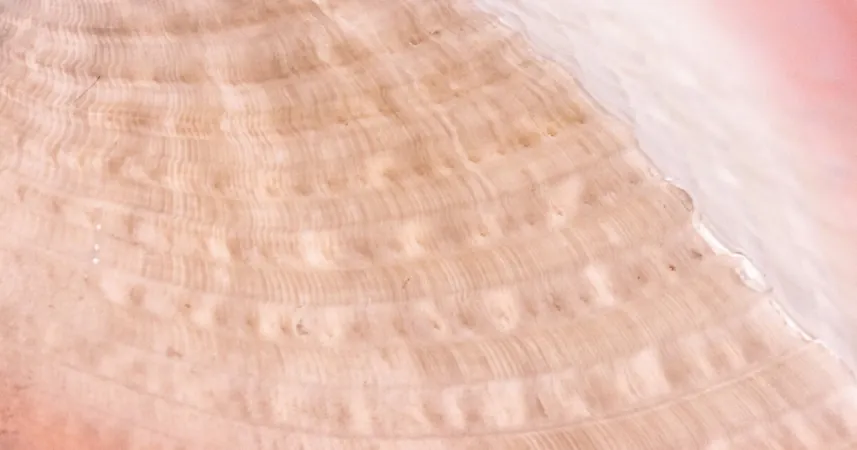
The Fascinating Link Between Heart Cockle Shells and Fiber Optic Innovations
2024-11-23
Author: Olivia
The Link Between Coral Bleaching and Heart Cockles
Healthy corals are often vibrant, teeming with life, and rely on a delicate relationship with algae to thrive. Coral provides a haven for these photosynthetic organisms, which in turn supply corals with essential nutrients. But when ocean temperatures rise, corals may bleach, expelling their protective algae and leaving behind a stark, lifeless skeleton. This phenomenon leads to less biodiversity in these once-rich ecosystems.
Biologist Dakota McCoy from the University of Chicago notes, “Bleached corals are left looking white or even black when they die, and the marine life around them suffers dramatically.” Yet, intriguingly, certain marine creatures, such as the heart cockle – a clam-like mollusc – exhibit resilience. These molluscs retain their algae during periods of environmental stress, bringing attention to their unique adaptations.
In McCoy's recently published study in Nature Communications, she reveals that the structure of the heart cockle's shell functions much like advanced fiber optic cables. This discovery has significant implications for both ecological conservation and optical engineering.
A Mysterious Marvel of Nature
To investigate the heart cockle's shell, McCoy and her team utilized LED lights to shine through the shells. Their findings revealed an impressive variety of light patterns, resembling everything from miniature stained glass to intricate zebra stripes. This led to deeper inquiry into the nature of the light passing through.
Using a device called a spectrophotometer, McCoy was able to analyze how much light penetrated the shells’ intricate structures. They discovered that heart cockle shells direct over double the amount of beneficial sunlight to their internal algae while filtering out potentially harmful ultraviolet (UV) rays. “These mineral lenses act as natural light concentrators,” McCoy explains, allowing sunlight to penetrate deeply enough to sustain the algae while preventing excessive intensity that could harm them.
Leading optical physicist Jennifer Dionne, who collaborated with McCoy, remarked on the distinctiveness of this occurrence, stating, "It's a remarkable adaptation that serves a dual purpose of structural integrity and light transmission."
Inspiration for Technology and Conservation
The study's implications extend beyond marine biology; they suggest ways to enhance technology. The fiber optic structure of heart cockle shells could inform the development of miniature cameras or more advanced fiber optic systems. "Understanding how biology effectively manages the flow of light can lead to significant advancements in engineering," Dionne states.
Mark Farmer, a cell biologist at the University of Georgia, acknowledges the study's contribution, highlighting the balance between the mechanical strength of shells and the necessity for light transmission. He points out that this adaptation could explain why heart cockles withstand stressful conditions better than corals, suggesting a vital strategy for coral conservation efforts.
With climate change increasingly threatening marine environments, the heart cockle's defense mechanisms provide valuable insights. By studying how these molluscs maintain healthy algae under stress, researchers hope to devise strategies for enhancing coral resilience, potentially leading to engineered corals that withstand environmental changes more effectively.
McCoy emphasizes the wisdom of nature, stating, "The heart cockle's ability to manipulate light demonstrates a sophisticated biological design refined through millions of years of evolution." This represents not just an exciting discovery in ocean biology but also an opportunity to harness natural innovations for technological advancements.
In the quest for sustainable solutions to climate challenges, the humble heart cockle could lead the way, showcasing nature's brilliance in creating efficient systems to utilize solar energy. As we face pressing environmental challenges, it’s clear that lessons from these remarkable creatures might be exactly what we need to inspire the future of both scientific research and technology.









 Brasil (PT)
Brasil (PT)
 Canada (EN)
Canada (EN)
 Chile (ES)
Chile (ES)
 España (ES)
España (ES)
 France (FR)
France (FR)
 Hong Kong (EN)
Hong Kong (EN)
 Italia (IT)
Italia (IT)
 日本 (JA)
日本 (JA)
 Magyarország (HU)
Magyarország (HU)
 Norge (NO)
Norge (NO)
 Polska (PL)
Polska (PL)
 Schweiz (DE)
Schweiz (DE)
 Singapore (EN)
Singapore (EN)
 Sverige (SV)
Sverige (SV)
 Suomi (FI)
Suomi (FI)
 Türkiye (TR)
Türkiye (TR)